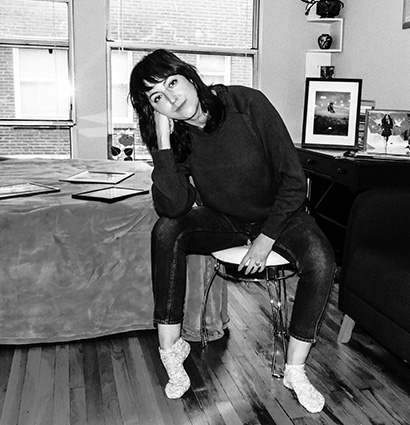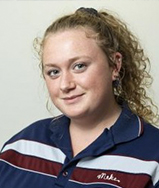In the modern age, the ever-present symptoms of the climate crisis, socio-political strain, civil unrest and more loom larger than ever in our lives. Oftentimes, this puts us in a reactionary position instead of one based in action and forethought on how to navigate these issues. For analogue collage artist Sierra Severson, there is a sort of magnetism that has always drawn her to muse on these world-shaping elements, resulting in an oeuvre of work that is both tangible and abstract.

Most recently, Severson’s work has found a home at Culturally Arts Collective’s latest exhibit, On The Rise — a 10-plus artist gallery focused on “Art, Action and Climate Justice” — which ran through the end of March. The primary theme of the virtual show is the “global undeniable challenge to deal with the consequences of decades of environmental destruction” — for Severson, a narrowed focus on this subject comes intrinsically, as does resourceful art making.
“I was raised with a strong sense of environmental responsibility. With collage, I only use materials that already exist, it could even be argued that analog collage is a creative form of recycling — recycling images, evolving them beyond their original meaning. It is important to me that I can engage in an art form that has a very low impact on the world and does not create waste or use toxic materials,” Severson added. “I also tend toward political commentary … it is important to me that my pieces can ‘speak’ about culture, political issues and this moment in time.”
Read on for Severson’s words on the beginnings of her artistry, how her craft utilizes “media saturation” and what it means to be a creator in the modern world.
Better: What are your origins as an artist — you’re a transplant to Chicago, yes?
Sierra Severson: I am from coastal California originally, but had been living in Seattle for six years before my move to Chicago. In Seattle, I worked in nonprofits, something I thought I wanted to do as a career. I started from the bottom with that, and honestly it was some of the hardest times of my life; first working with refugees, night shifts at a women’s shelter, working at a youth shelter, then ultimately working with adults with disabilities. Social work is incredibly underpaid, and it’s hard not to feel hopeless about the quality of life for marginalized people in our current economic system. These experiences, as well as my study of Cultural Anthropology, are constantly informing my pieces.
Art has always been in my life, I started painting as a kid. But during this time I started collaging as a form of self care, a therapy to deal with the intensity of my work. Then I started showing in bars and cafes around the city, thanks to the prodding of friends. Over the pandemic, when we were all getting checks to stay home, my practice really flourished. I finally had the time and the energy to devote to art everyday, it was a real turning point. I began to take myself seriously as an artist. I had a couple of friends who came to Chicago and I was looking for a change so I decided to make the move last summer. I came here as an artist to focus on art, and that mental shift has been incredibly empowering.
What does the medium of analogue collage mean to you — has the form lended itself to the meaning you strive for?
Analog collage is accessible, all that’s needed is paper, scissors and an adhesive. No expensive materials, you don’t need to have a large studio or rely on any technology beyond your own hands. I have always loved collecting books and visual ephemera, and it was thrilling to me to be able to use these images and create something brand new. I love the idea of working from a whole world of images that already exist. We live in a time of such media saturation, it feels empowering to grab hold of these images and give them new life, meaning, make them my own.
Where do you find inspiration for your work? How does the discovery of source material play into that?
Collage began as my therapy, so it really acts as a way for me to process the world; the political climate, city life, what it means to be a woman in 2023. I am also heavily impacted by the materials I find. I buy used books from bookstores, thrift stores and estate sales. Sometimes I let that guide my work, or sometimes I will have a fully developed idea that prompts me to search for specific images and materials. I also create in response to other work. When I am in a rut, I will go to the Art Institute of Chicago or get carried away by music and suddenly get a rush of ideas. Music is definitely a catalyst for me creatively.
In 2019, I went to Edinburgh with a friend and happened to be there when the exhibit “Cut and Paste: 400 Years of Collage” was at the National Gallery. I met with one of the curators and explored the exhibit and this was immensely impactful. It was the first time I saw pieces from DADA artists such as Hannah Höch — who instantly became an art heroine for me.
What impact do you hope your work will have on audiences who interact with it?
I would like my work to ignite curiosity in viewers’ own beliefs and thought processes. I hope to inspire introspection, as [my work] comes from a place of introspection. Honestly, one of my favorite things about art is that you make your piece and that’s that, you can’t control how it will be perceived. That is why I often have a hard time titling my pieces, I don’t want to over reach and tell viewers what is going on, I’d rather have them arrive on their own.
More from Better:
- Jane Goodall Shares 3 Reasons She’s Optimistic About the Future of the Environment
- Q&A: Ric Estrada, CEO of Metropolitan Family Services, on the Importance of Deep Understanding in a People-First Profession
- Star Wars Actress Ashley Eckstein Talks Mental Health, Becoming Ahsoka and Standing Up for Female Fans

Margaret Smith is a Chicago-based writer and editor with a passion for socio-political storytelling about their community. They are a graduate of Columbia College Chicago.
